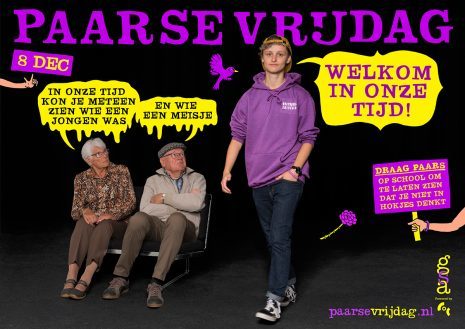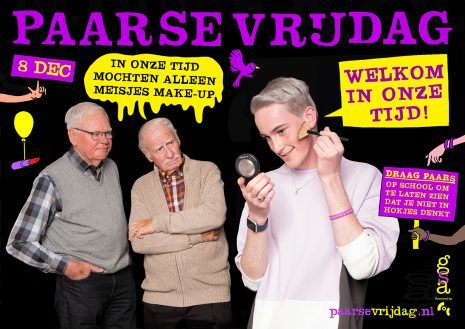
The Dutch organization for LGBT men and women - COC Nederland - organized this year's 'Purple Friday' across more than 900 high schools. This year's theme was 'pigeonholing'. An article on the COC website explains what they mean:
Around 250,000 students will wear purple clothing on that day to show that everyone can be themselves at school, whatever your sexual orientation or gender identity is. This year, students will be campaigning against pigeonholing. Can a boy wear make-up at school? Is it alright if a girl wants to be a car mechanic? Can boys kiss with boys and girls with girls? Will students who don't feel comfortable with the label 'boy' or 'girl' also be accepted? These are the type of questions students will ask on Purple Friday with posters, events, parties and by wearing the color purple.

An article on this topic appeared in the free Dutch newspaper Metro - the country's second-largest - that included comments by a 15-year-old boy who goes to school dressed in clothes - short skirts and long heels - which are provided by his mother. The boy in question, Sebastien, told Metro:
"There are a lot of people who still think according to old habits. That men have to be cool and not wear any make-up. I know that youngsters of this generation are very active with being able to express themselves. At our school a lot of attention is being given to topics such as bullying. That's not just about sexuality, but also about racism."Not everyone is as accepting of this radical change in the cultural climate however. When the article was posted on social media by Metro, one person wrote:
"How far are they forcing you to accept all of this, by saying it's all fine and dandy? I have the impression that there will always be someone who will try to go even further over the boundaries. And everyone has to just accept that. Well, not me. Honestly, I'm slowly starting to get fed up with all this, and would like to urgently advise that if anyone feels like presenting themselves to the outside world in an even more extreme way than this, please seek a psychiatrist."In a healthy society, Sebastien and others like him would be offered help and encouraged to dress decently. In a cruel and ponerized society, this behavior is labeled 'normal' and encouraged, and children like Sebastien used as propaganda ploys. No attempt is made, it seems, to truly help children with gender dysphoria. They are, instead, actively encouraged to start hormone therapy and consider surgery. I can't really think of a more irresponsible way for a supposedly responsible education system (and parents) to treat their children.
Consider the fact that a large percentage of prepubescent children distressed by their biological sex eventually outgrow that distress by late adolescence. By manipulating and shaming people to accept that children who are confused about their 'gender identity' are normal, the natural process whereby these children would outgrow this problem is upended. Organizations like COC claim they are respecting the child's right to decide for itself, but that is clearly not the case because they are actively creating a social and cultural climate where one outcome - gender reassignment therapy - is promoted over others. The end result is that children who are too young or immature to understand the implications of their choice are undergoing harmful and sometimes irreversible hormone 'therapy' and surgery that they will likely regret later in life.
In the end, 'Purple Friday' isn't helping children to freely express themselves because there is no 'freedom' in a society ruled by a radical ideology like the one that has taken hold in Western nations. As one Dutch campaign tried to say: "Let boys be boys!" As the organization behind that campaign emphasized: If boys are suppressed in their behavior - wrestling, fighting and taking risks - it can lead to lower self-esteem, less motivation and lesser capability of holding their concentration. There are clear biological reasons why this would be the case, and biology is fixed.
With campaigns such as the one promoted by COC Netherlands, children - whose brains are not fully developed - are forced to consider and act on beliefs about themselves and their society that, for now, will merely serve to confuse and alienate them from the rest of the population. They are being induced to be part of a new, radically liberal, society that seems determined to ensure that, ultimately, no social or cultural norms or rules apply.




Reader Comments
Actually, the human brain is fully hard-wired between birth and ages 9 or 10, maybe 11. At 15, Sebastien's brain is fully developed. That doesn't mean there are no complications.... Lots of kids suffer from loneliness owing to withdrawal brought on my smartphone addiction, broken (family or friends) relations, fear of tomorrow....
Remember the Who?... the kids are all right
and Floyd?... leave those kids alone
oh ya - you want a place that has "social and cultural rules"?... try Saudi Arabia